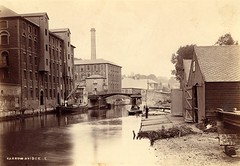IMAGINE you’re a county council with a fantastic archive of old photos. You’ve got a great online search system but you still feel you could reach a wider audience. What do you do? Well if you’re Picture Norfolk you dip a toe in the wonderful world of Flickr and see what happens.
This photo shows the River Wensum just downstream of Carrow Bridge with Colman’s factories dominating the left bank. And it’s one of 36 photos that Picture Norfolk have published on Flickr within the last couple of months. One of the problems with being so open of course is that bloggers like me come along and cheekily republish. Hey, come on guys, I’m a huge fan and it’s a huge plug too.
So let’s take a closer look at this late 19th century scene. First that’s the old Carrow Bridge some distance downstream from the current one. It was originally directly opposite Carrow Hill and ran directly through Colman’s factories. Hence the mustard company was keen to reposition both road and bridge. The replacement – which survives to this day - was opened in 1923.
That’s a wherry of course moored next to Colman’s. I’m no expert but it looks pretty high in the water. Waiting to be loaded with goods to be sent down to Yarmouth perhaps? My money’s on the wherryman having a crafty pint at one of the dozens of boozers which lay along neighbouring King Street at this time. The boatsheds on the right bank are a surprise to me. Would these have been for boatbuilders or for more recreational use? Help if you can.
And finally I’m guessing that the tall chimney would have belonged to the riverside brewery firm Youngs, Crawshay and Youngs. Their operation was on the site of the modern Wensum Lodge.
* For more pictures of Norfolk check out Picture Norfolk’s other flickr photos here. or do it the old school way here.


































